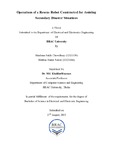| dc.contributor.advisor | Rhaman, Dr. Md. Khalilur | |
| dc.contributor.author | Chowdhury, Shadman Sakib | |
| dc.contributor.author | Nawal, Mehbas Fairuz | |
| dc.date.accessioned | 2015-09-01T09:59:29Z | |
| dc.date.available | 2015-09-01T09:59:29Z | |
| dc.date.copyright | 2015 | |
| dc.date.issued | 2015-08 | |
| dc.identifier.other | ID 12121130 | |
| dc.identifier.other | ID 12121166 | |
| dc.identifier.uri | http://hdl.handle.net/10361/4348 | |
| dc.description | Cataloged from PDF version of thesis report. | |
| dc.description | Includes bibliographical references (page 32). | |
| dc.description | This thesis report is submitted in partial fulfillment of the requirements for the degree of Bachelor of Science in Electrical and Electronic Engineering, 2015. | |
| dc.description.abstract | Combination of vulnerability to natural calamities as well as the worldwide affinity for robotics led to the emergence of the topic. With increasing frequency of natural hazards, the number of infrastructural damage and population death has rocketed in the past decade. This paper highlights an approach to combat the ramifications of natural catastrophe in perspective of Bangladesh, a country highly susceptible to disasters. Predicting calamities is still remarkably a futile effort- for instance; seismologists are yet not reliable enough to predict forthcoming earthquakes even in the month of occurrence. Hence, the work done to mitigate the damage is often through post-disaster-search-and-rescue-tactics. The aim of the paper is to develop a ‘Rescuebot’ that inherits cognitive framework for life detection through rubble. Bangladesh is a developing country, and the purpose of the project is to construct the country’s very own rescue machine that can crawl through debris of earthquake and landslides and maintain signal strength using boosters at minimum cost. The robot also has an audio/video monitoring ability with the aid of a digital camera with an adjacent LED torch. The motion of the vehicle is remotely controlled and communication is done through the use of Wi-Fi beacons. The real time audio, video transmitted from robot to monitor screen via Wi-Fi is processed by person controlling its motion thereby, an approximate conclusion is reached regarding the presence of victim. Hence, processing and transmission cost of real-time data is reduced. This robot can provide a simpler, more reliable and cheaper way to traverse in all types of terrain and locate victims.
Keywords: rescue robot, signal boosters, Wifi, beacons | en_US |
| dc.description.sponsorship | This thesis report is submitted in partial fulfillment of the requirements for the degree of Bachelor of Science in Electrical and Electronic Engineering, 2015. | en_US |
| dc.description.statementofresponsibility | Shadman Sakib Chowdhury | |
| dc.description.statementofresponsibility | Mehbas Fairuz Nawal | |
| dc.format.extent | 32 pages | |
| dc.language.iso | en | en_US |
| dc.publisher | BRAC University | en_US |
| dc.subject | Electrical and electronic engineering | en_US |
| dc.subject | Rescue robot | en_US |
| dc.title | Operations of a rescue robot constructed for assisting secondary disaster situations | en_US |
| dc.type | Thesis | en_US |
| dc.contributor.department | Department of Electrical and Electronic Engineering, BRAC University | |
| dc.description.degree | B. Electrical and Electronic Engineering | |
| dcterms.rights | BRAC University thesis are protected by copyright. They may be viewed from this source for any purpose, but reproduction or distribution in any format is prohibited without written permission. | |

